Food for fighters
As long as there have been organised military forces, there have been food rations to keep the collective fighting machine firing (besides foraging; that’s a story for another day).
Military rations have come in many sizes, flavours and configurations over the past 500 or so years. Modern food ration packs have evolved over the years, from a box of crackers and cigarettes, to self-heating high calorie meals. The basic idea of a field ration is to put together enough food for one man for one day. Unfortunately for the troops, 'taste' was not always a consideration.
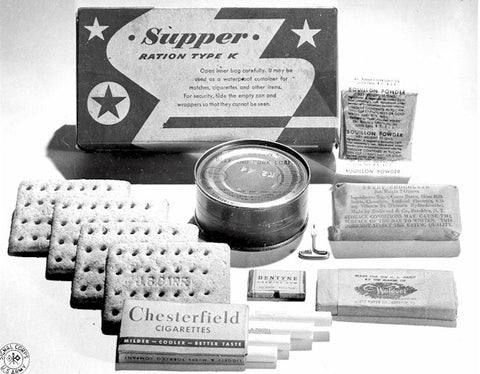
In this article we’ll focus on the last 30 years, since the introduction of “Meals, Ready to Eat” or MREs.
MREs are individual field rations in a lightweight, self-contained package. The MRE has replaced the various less-appetising ration packs that came before them.
They are a United States military initiative that evolved from research in the 1960s. MRE is the standard ration in the US, and similar products are known by different names in different parts of the world, for example the “Individual Meal Pack” or IMP in Canada.
Although the US military developed the ration packs and facilitated their creation for troops, the MRE has also found many non-government uses.
If they’re good for the military, then MREs are also good for outdoorsy types, and they are an essential item for any survival kit. They last a long time, don’t take up much space or weight, and they’re packed full of life-sustaining nutrition.
Frankly, the alternatives in long-lasting food aren’t great: you’ve got wet rations (canned food), or dry rations (dried or freeze-dried food), which the US Space Program smartly replaced with MREs in 1983.
Although people’s survival kit contents may vary wildly, one item that’s always necessary for survival is food. MREs are ideal emergency food. They can be very helpful to have on hand in many situations, whether it be a tight spot in the outdoors or New Zealand natural disasters such as an earthquakes or floods.
10 Reasons MREs are a good solution:
- Easy to prepare
- Long shelf life
- Waterproof
- Fresh-packed in retort pouch
- Can be eaten hot or cold
- No refrigeration needed
- Ready to eat in a few minutes (depending on heating method)
- Cook with boiling water or the included flameless heater
- Easy to open – no can opener required!
- Food already contains moisture, so it doesn’t need to be reconstituted like dehydrated or freeze-dried food
Who eats MREs?
Campers, trampers, hikers, hunters, soldiers, preppers, sportspeople, emergency service workers, teenagers left to fend for themselves over the weekend, hungry people. Buying and storing emergency food is for anyone wanting piece of mind knowing they are prepared for themselves and their family in emergency situations.
Retort Pouches and Flameless Heaters
The two big leaps in technology that have propelled ration packs to their current gastronomic heights are the pouches they are maintained in and the convenience of flameless heating. Let's look at both of these technologies a bit closer.
Retort Pouches
Thermostabilized, laminated food pouches, otherwise known as retort pouches (named after the retort cooker) made an appearance in the mid-1970s. The US Space program were early adopters of the technology, searching for tasty, easy to prepare food that would not tax the body the way freeze-dried and toothpaste tube food did. The Space program still uses the retort pouch to this day.

Flameless Heaters
Without reaching for the chemistry textbook, a simplified explanation of how these heaters work goes like this: when water is added to the heater bag, it mixes with salt which rapidly corrodes the magnesium particles in the heat pack. It’s basically like thousands of short-circuited batteries burning out fast, and creating heat in the process. Don’t worry; none of those chemical reactions get into your food!
How long do they last?
The chart below shows rough estimates of MREs and their shelf life based on storage temperature.
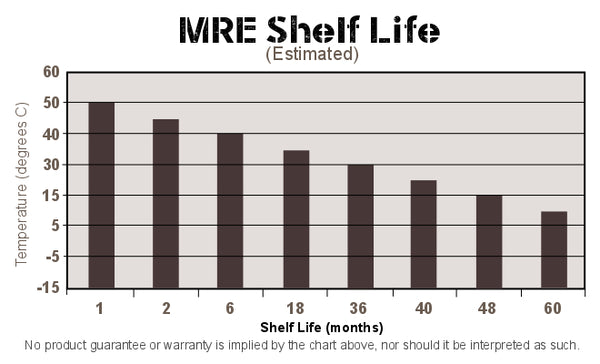
The data for this graph was collected by asking people whether the taste was “acceptable”, so the food will still be edible for a while after this time has passed, but it might not taste good. Taste is also pretty subjective, so it can vary from person to person. This information is provided as a general indication of the effects of storage temperature on MRE-type packaged foods and not necessarily a guarantee from the manufacturers.
So what do these things actually have in them?
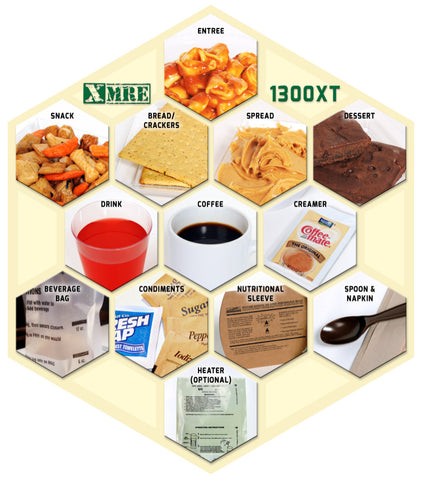
Well, each complete MRE kit is a sealed plastic packet containing several items. They provide balanced nutrition, and enough food to fill up most hungry people (remember, they were developed for physically active soldiers).
Each MRE may contain 500 to 3000 or more calories, depending on the configuration. Our XMREs have approximately 1300 calories.
Contents (may vary):- 1 227gm main meal (entree)
- 1 cracker/bread
- 2-3 snacks/desserts/sides
- 1 fruit-flavoured beverage
- 1 spread/sauce
- Military spoon and serviette
- 1 instant coffee
- 1 non-dairy creamer
- 1 wet towelette
- Flameless heater
XMREs can generally be bought individually or in packs of 12.
How to heat MREs
Soldiers, emergency relief workers, campers, hikers and hungry people all around the world have – at times – been forced to eat cold MREs. This isn’t ideal, but a benefit of their pre-cooked nature is that they can be eaten cold if necessary. A hot meal is usually preferable, and there is three easy ways to heat XMREs up:
Boiling
Remove the food pouch from outer carton and put it in boiling water for 5-7 minutes. Easy.
Flameless heater
If you have the type of MRE that comes with a flameless heating bag in it, then that is probably the easiest and quickest choice for heating. Pour some cold water into the heating bag, then put your sealed food pouch in the heating bag and wait until it’s hot. It comes with a fold-together cardboard holder so you don’t burn yourself when handling it.
Microwave
Be sure to remove the meal from its pouch first. The pouch contains an aluminium, non-microwaveable layer. This gives it a long shelf life, but will react if put in a microwave. Heat the food in the microwave for 2-3 minutes.

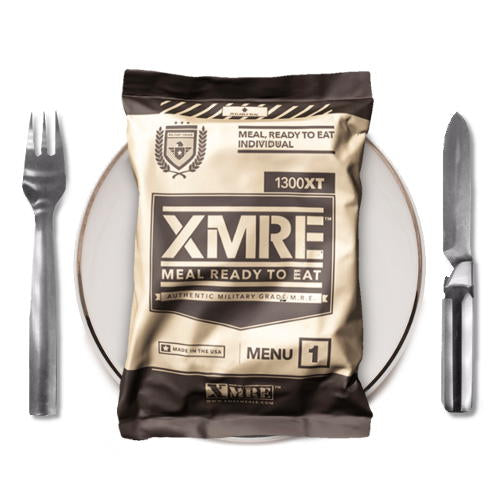
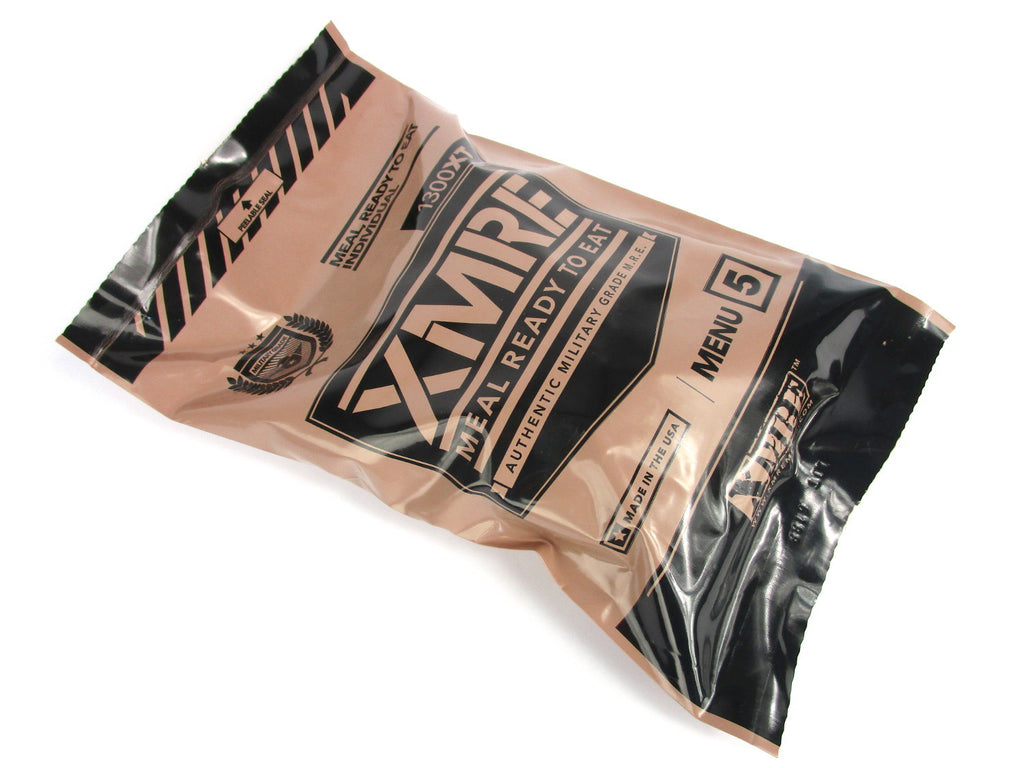





7 comments
sandra
Hi there Team at Army and outdoors. Will there be any MRE boxes i can order at all? Thanks Sandra
Army and Outdoors
Hi there Craig.
We will not be getting the MRE boxes back in stock for the foreseeable future. You can still purchase the MRE’s separately and select your own flavours.
Cheers,
-Army and Outdoors
Craig Lilford
When are the MRE boxes due back in?
Army and Outdoors
Hi there Charles.
We’ve added you to our mailing list, these usually come every Thursday evening. If you need info on MRE’s, feel free to ask.
Cheers,
-Army and Outdoors
Charles Hermes
Please add me to your mailing list. I’m interested in single MRE packs
Army and Outdoors
Hi Denis.
We are expecting a shipment of both single MRE’s and boxes in 2-3 weeks, mid March. Hopefully you can hang on till then.
Cheers,
-Army and Outdoors
Denis
Looking for some more of these in boxes to come back in to stock…